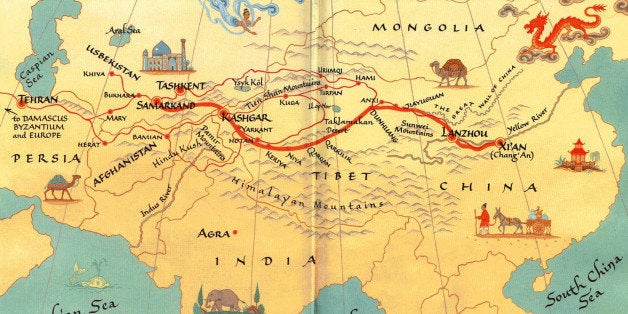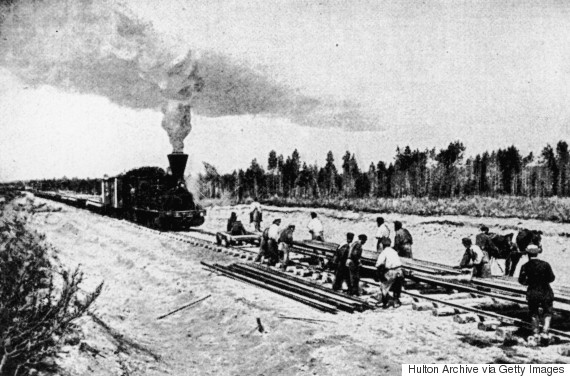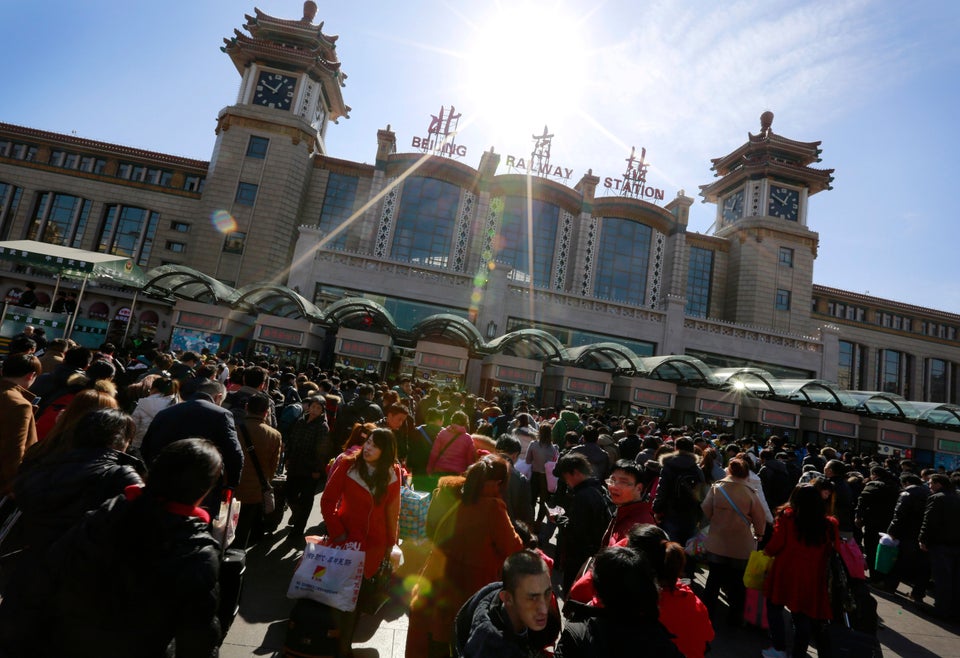
SINGAPORE -- For centuries the historical Silk Road connected Asia and Europe by land and by sea. The new proposal of China, while reviving the ancient concept of the Silk Road, aims to carry forward the spirit of peace, cooperation, openness and inclusiveness for shared benefits.
Naturally, it takes time for people to fully take in a big idea. The first challenge is choosing a good translation that captures the world's imagination. This initiative is translated into English as the "Belt and Road" initiative. I have been asked many times to explain what this means. The first question is always, "Why does China want a belt built on land and a road built in the sea?"
What Chinese President Xi Jinping means to convey is a renewed connectivity both within Asia and between Asia and Europe, both by land and by the sea, and both by means of strengthening traditional infrastructure and through building highways of trade, finance and cultural exchange to strengthen connectivity.
There has already been a warm response from more than 60 countries and a number of international organizations. And there are ongoing discussions at bilateral, multilateral and regional levels on how to take the initiative forward through concrete projects, such as the China-ASEAN upgraded Free Trade Area, the Bangladesh-China-India-Myanmar economic corridor, dovetailing with the Eurasian Economic Union and the setting up of the Asian Infrastructure Investment Bank. All of these fit together with many other domestic programs.

The Aspiration for Asia-Europe Connectivity
To connect Asia and Europe from the Atlantic to the Pacific through land has long been a dream. The two continents have made many attempts over the past one hundred years.
In the 19th century, for example, Russia built the Trans-Siberian Railway, successfully connecting the Baltic Sea to the Pacific, which is known as the northern line. However, that railway was more for security purposes and brought little economic benefits.
The second railway effort is known as the Eurasian Bridge that runs through the center of the region. In 1990, China extended a railway through the extreme end of the Xinjiang Autonomous Region to Kazakhstan, which enabled a connection from Lianyungang port on China's Pacific coast to European networks all the way to Rotterdam.
I myself made a field trip to the Alashan Pass in the mid 1990s and found that, because the rails on the Chinese side and those on the other side of Kazakhstan were not of the same gauge, goods brought by trains had to be moved from the trains that fit one gauge and reloaded to another train of another gauge. I saw lines of trains waiting to be unloaded and loaded. This made the concept of connectivity more academic than real in those years.
The third line is in the south. Quite a few railway lines were constructed within China from north to south, with the the idea of connecting China and Southeast Asia all the way to Malaysia, and from Singapore all the way to India. This network has never been fully realized.
"Across the vast land space of China, we have in those intervening decades built a network of highways and the world's longest high-speed railway system."
In the 1990s the Asian Development Bank also proposed a series of Asia infrastructure network programs. The Kunming-Bangkok Highway was built by joint efforts of the ADB and China, Laos and Thailand together.
These efforts show that the vision of connecting Asia and Europe has remained alive all these years. No doubt the recent support for China's AIIB is probably deeply rooted in this very dream of Eurasian connectivity.
However, while those grand ideas would occasionally come up at discussions by ASEAN and China at official and academic levels over the years, they would have to wait for the right conditions and the right vision.
In the past, the capital necessary to undertake such a grand project was not available and technology was not up to the required level. More importantly, China itself did not have the necessary infrastructure network at that time to make Eurasia connectivity work by supporting it from a base in the center of the region.
Twenty years on, those two constraints have more or less disappeared. Across the vast land space of China, we have in those intervening decades built a network of highways and the world's longest high-speed railway system.
More importantly, China has come a long way in terms of economic strength with plentiful capital and upgraded technology. It is in this context that China put forward such a big initiative not only for further development in China but more importantly, for a higher level of growth in Asia and beyond.
All-Round Connectivity Promotes Peace, Stability and Economic Prosperity of the Region and Beyond
A country like Singapore sits on the world's most vital arteries of trade between Asia and Europe. It is poised to play a very important part by virtue of being a gateway.
As we all know, however, most Asian countries are less prosperous inland than in the coastal regions. The lack of transportation and development facilities have left many people behind, including among the Southeast Asian countries as well as in the vast region of China's western interior and the vast and very important region lying between China and Europe. Poverty, as we know, leads to instability and engenders problems such as human and drug trafficking and terrorism.
China is both a land and maritime country. Its inland area is four times as big as the eastern coastal region but lags far behind. But the potential is also huge. Western China, which lies at the center of Eurasian continent, offers the advantage of being a platform that can connect commerce both southwards and westwards.
Likewise, other maritime countries like Indonesia and Malaysia also need to improve connectivity inland so as to allow them to catch up with the new wave of growth in Asia.
By developing more arteries for connectivity, we should be able to build new blood vessels of development for disadvantaged economies in Asia's hinterlands to create prosperity and opportunities and improve the competitiveness of the whole region.
Connectivity Programs -- The New Driving Force for Cooperation
China is now the No. 1 trading partner of most Asian countries.
Among those countries which have announced their support for President Xi's initiative, trade with China has mostly been growing by double digits. We hope when the initiative is translated into more cooperation projects in those countries, trade will grow further.
Take Singapore, for example. China and Singapore are not only important trade partners. Two-way investment has also grown with a strong momentum. Singapore has turned into China's top foreign investor in the last two years. Chinese investment in Singapore is also picking up. I'm sure that this momentum will be reinforced by the implementation of the Silk Road initiative.
In the wider context, generally speaking, Asia is yet to tap its full potential.
According to the Asian Development Bank, 600 million people in Asia have no access to electricity. The demand for infrastructure between 2010 to 2020 is estimated to be as high as $8 trillion.
The Silk Road Fund set up by China of $40 billion, and the AIIB with an initial capital of $100 billion, will help jumpstart the region's infrastructure and the overall development drive.
"In China, we say that connectivity is the shortcut to prosperity. That is what we have experienced in recent decades."
In China, we say that connectivity is the shortcut to prosperity. That is what we have experienced in recent decades. Now China would like to share this experience crucial to success with other countries.
Chinese companies are capable of providing high quality, low cost and affordable infrastructure projects. They are already active in the region. According to the Ministry of Commerce, between January and May this year, Chinese companies signed up for more than 1,000 projects.

Singapore's Role
In many ways Singapore has a crucial role to play. Singapore, as an important navigation, shipping and logistics center with advanced infrastructure, can be an important transit point and service provider for the maritime and land Silk Road programs.
Second, Singapore is an important financial center and the second biggest offshore RMB clearing center. This puts Singapore in a better position to provide trade, financing and investment services for the region.
Third, Singapore will be the country coordinator for China-ASEAN relations for the next three years. We count on Singapore to facilitate such important undertakings as the upgraded China-ASEAN FTA, the Regional Comprehensive Economic Partnership, and working towards an Asia-Pacific Free Trade Agreement.
We would also look to Singapore in leading regional connectivity projects.
At the moment, China and Singapore are in discussions about launching a new flagship project on connectivity and a modern service industry in west China. This will definitely strengthen Singapore's ability to join the Silk Road development on land as well.
Challenges and Response
Any good initiative needs to be tested in its implementation. The Asia-Europe connectivity is also confronted with difficulties and challenges.
First, we need to build understanding. Admittedly, it's always been a challenge for China to communicate its thinking and ideas to the outside world. There are, of course, language difficulties. It's also a challenge to put conceptualized initiatives into more concrete practice.
Furthermore, to promote better understanding China should also listen more to its neighbors. The Silk Road initiative is an open and inclusive program geared toward common development from day one. It is therefore important to nurture the comfortable level of trust in order for the initiative to be successful.
"The Silk Road initiative is an open and inclusive program geared toward common development from day one."
Second, we need to be aware of security and other risks. Infrastructure projects are long-term and slow to show immediate returns. The success of projects depends entirely on the sovereign countries for ensuring the necessary environment and conditions while the companies themselves should base their decisions on proper risk assessment. Of course, good connectivity programs will also, in return, reinforce stability.
Third, we need to allow the companies and the market to determine what to do and what not to do, as connectivity programs concern specific projects. Economic viability holds the key to their success. What governments can do is to provide policy guidance and legal ground and the necessary facilities.
The list of challenges may go on. But the warm response we've seen to the initiative speaks to the keen interest.
I hope I'm not overstating the case to say that the region has never been so united and so full of hope for connectivity in all fronts and at all levels.
Should we achieve the success of the Silk Road initiative, it will not only create new development opportunities but also prosperity for hundreds of millions of people. There is no doubt in my mind that, if we cooperate as equal partners to build connectivity, everyone will benefit. "Let's work together" ought to be our guiding motto.
This article is adapted from remarks given by Fu Ying to the China-Singapore Business Council in Singapore on July 27.

